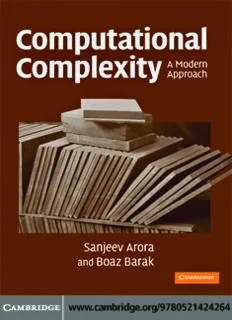Table Of ContentThis page intentionally left blank
COMPUTATIONAL COMPLEXITY
Thisbeginninggraduatetextbookdescribesbothrecentachievementsand
classicalresultsofcomputationalcomplexitytheory.Requiringessentially
nobackgroundapartfrommathematicalmaturity,thebookcanbeused
asareferenceforself-studyforanyoneinterestedincomplexity,including
physicists,mathematicians,andotherscientists,aswellasatextbookfor
avarietyofcoursesandseminars. Morethan300exercisesareincluded
withaselectedhintset.
The book starts with a broad introduction to the field and progresses
toadvancedresults. ContentsincludedefinitionofTuringmachinesand
basic time and space complexity classes, probabilistic algorithms, inter-
active proofs, cryptography, quantum computation, lower bounds for
concretecomputationalmodels(decisiontrees,communicationcomplex-
ity, constantdepth, algebraicandmonotonecircuits, proofcomplexity),
average-casecomplexityandhardnessamplification,derandomizationand
pseudorandomconstructions,andthePCPTheorem.
Sanjeev Arora is a professor in the department of computer science at
PrincetonUniversity.Hehasdonefoundationalworkonprobabilistically
checkable proofs and approximability of NP-hard problems. He is the
foundingdirectoroftheCenterforComputationalIntractability,whichis
fundedbytheNationalScienceFoundation.
BoazBarakisanassistantprofessorinthedepartmentofcomputerscience
atPrincetonUniversity.Hehasdonefoundationalworkincomputational
complexity and cryptography, especially in developing “non-blackbox”
techniques.
COMPUTATIONAL
COMPLEXITY
A Modern Approach
SANJEEV ARORA
PrincetonUniversity
BOAZ BARAK
PrincetonUniversity
CAMBRIDGE UNIVERSITY PRESS
Cambridge, New York, Melbourne, Madrid, Cape Town, Singapore, São Paulo
Cambridge University Press
The Edinburgh Building, Cambridge CB2 8RU, UK
Published in the United States of America by Cambridge University Press, New York
www.cambridge.org
Information on this title: www.cambridge.org/9780521424264
© Sanjeev Arora and Boaz Barak 2009
This publication is in copyright. Subject to statutory exception and to the
provision of relevant collective licensing agreements, no reproduction of any part
may take place without the written permission of Cambridge University Press.
First published in print format 2007
ISBN-13 978-0-511-53381-5 eBook (EBL)
ISBN-13 978-0-521-42426-4 hardback
Cambridge University Press has no responsibility for the persistence or accuracy
of urls for external or third-party internet websites referred to in this publication,
and does not guarantee that any content on such websites is, or will remain,
accurate or appropriate.
Toourwives—SilviaandRavit
Contents
Aboutthisbook pagexiii
Acknowledgments xvii
Introduction xix
0 Notationalconventions . . . . . . . . . . . . . . . . . . . . . . . . . . . 1
0.1 Representingobjectsasstrings 2
0.2 Decisionproblems/languages 3
0.3 Big-ohnotation 3
exercises 4
PARTONE: BASICCOMPLEXITYCLASSES 7
1 Thecomputationalmodel—andwhyitdoesn’tmatter . . . . . . . . . . 9
1.1 Modelingcomputation:Whatyoureallyneedtoknow 10
1.2 TheTuringmachine 11
1.3 Efficiencyandrunningtime 15
1.4 MachinesasstringsandtheuniversalTuringmachine 19
1.5 Uncomputability:Anintroduction 21
1.6 TheClassP 24
1.7 ProofofTheorem1.9:UniversalsimulationinO(TlogT)-time 29
chapter notes and history 32
exercises 34
2 NPandNPcompleteness . . . . . . . . . . . . . . . . . . . . . . . . . . 38
2.1 The Class NP 39
2.2 ReducibilityandNP-completeness 42
2.3 TheCook-LevinTheorem:Computationislocal 44
2.4 Thewebofreductions 50
2.5 Decisionversussearch 54
2.6 coNP,EXP,andNEXP 55
2.7 More thoughts about P,NP,and all that 57
chapter notes and history 62
exercises 63
vii
viii Contents
3 Diagonalization . . . . . . . . . . . . . . . . . . . . . . . . . . . . . . . 68
3.1 TimeHierarchyTheorem 69
3.2 NondeterministicTimeHierarchyTheorem 69
3.3 Ladner’s Theorem: Existence of NP-intermediate problems 71
3.4 Oraclemachinesandthelimitsofdiagonalization 72
chapter notes and history 76
exercises 77
4 Spacecomplexity . . . . . . . . . . . . . . . . . . . . . . . . . . . . . . 78
4.1 Definitionofspace-boundedcomputation 78
4.2 PSPACE completeness 83
4.3 NL completeness 87
chapter notes and history 93
exercises 93
5 Thepolynomialhierarchyandalternations . . . . . . . . . . . . . . . . 95
5.1 TheClass(cid:3)p 96
2
5.2 Thepolynomialhierarchy 97
5.3 AlternatingTuringmachines 99
5.4 Time versus alternations: Time-space tradeoffs for SAT 101
5.5 Definingthehierarchyviaoraclemachines 102
chapter notes and history 104
exercises 104
6 Booleancircuits . . . . . . . . . . . . . . . . . . . . . . . . . . . . . . . 106
6.1 Boolean circuits and P/poly 107
6.2 Uniformlygeneratedcircuits 111
6.3 Turingmachinesthattakeadvice 112
6.4 P/polyand NP 113
6.5 Circuitlowerbounds 115
6.6 NonuniformHierarchyTheorem 116
6.7 Finergradationsamongcircuitclasses 116
6.8 Circuitsofexponentialsize 119
chapter notes and history 120
exercises 121
7 Randomizedcomputation . . . . . . . . . . . . . . . . . . . . . . . . . 123
7.1 ProbabilisticTuringmachines 124
7.2 SomeexamplesofPTMs 126
7.3 One-sidedand“zero-sided”error: RP,coRP,ZPP 131
7.4 Therobustnessofourdefinitions 132
7.5 Relationship between BPP and other classes 135
7.6 Randomizedreductions 138
7.7 Randomizedspace-boundedcomputation 139
chapter notes and history 140
exercises 141
Description:classical results of computational complexity theory. active proofs, cryptography, quantum computation, lower bounds for concrete A Modern Approach .. tion in living things was triggered by the discovery of self-reproduction in

